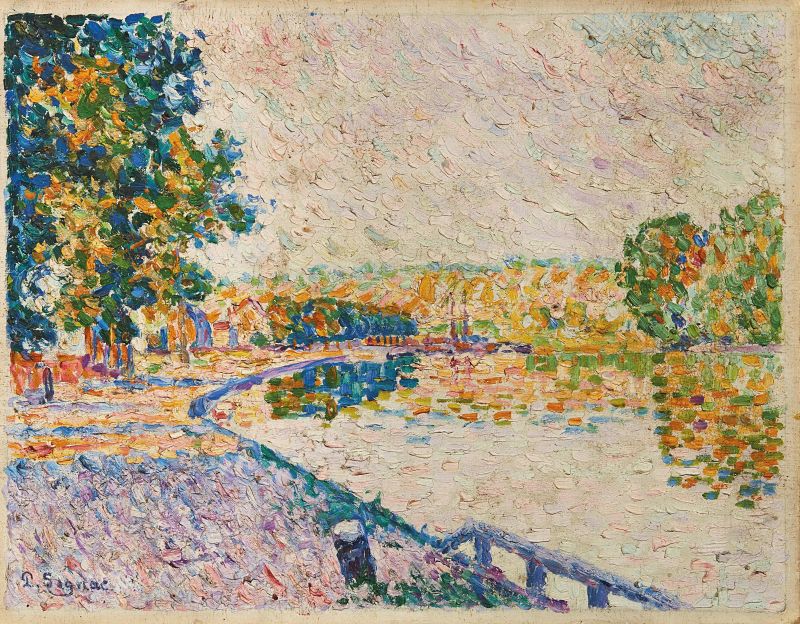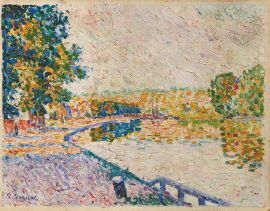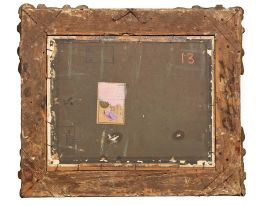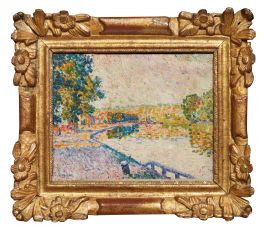Paul Signac
(Paris 1863 - 1935)
SAMOIS. ÉTUDE N. 11
1899
firmato in basso a sinistra
olio su cartoncino telato
cm 27x34,6
sul retro: timbri della Galleria Annunciata di Milano, etichetta non identificabile
SAMOIS. ÉTUDE N. 11
1899
signed lower left
oil on canvas board
10 5/8 by 13 5/8 in
on the reverse: stamps of the Galleria Annunciata in Milan, unidentifiable label
L’opera è corredata di attestato di libera circolazione.
An export license is available for this lot.
Provenienza
Milano, Galleria Annunciata
Finarte, Milano
Rovereto, Paolo Dal Bosco
Esposizioni
Exposition d’Oeuvres de Paul Signac, Galerie de l’Art Nouveau Bing, Paris, 1902, nn. 10 21.
Bibliografia
E. Cousturier, Gazette d’Art. Exposition d’oeuvres de Paul Signac, in “La Revue Blanche”, 28, giugno 1902, pp. 213-214 (ried. 1969)
A. Fontainas, Art Moderne, in “Mercure de France”, 43, luglio-settembre 1902, pp. 243-247.
F. Cachin, Signac. Catalogue raisonné de l’oeuvre peint, Paris 2000, p. 244, n. 348.
Pittore parigino, noto per essere stato l’artefice, assieme a Georges Seurat, del pointillisme, il movimento pittorico legato la scomposizione del colore in piccoli puntini, agli inizi degli anni Ottanta scopre la sua vocazione pittorica agevolata dalla frequentazione dell’ambiente artistico legato a Montmartre, il quartiere in cui inizialmente risiede con la sua famiglia. Alla morte del padre, si trasferisce ad Asnières-sur-Seine, alla periferia nord-ovest di Parigi, luogo a cui si ispirano le sue prime vedute. Nel 1884, espone i suoi quadri al Salon des artistes indépendants che ospita le opere di circa 400 artisti rifiutati dal Salon officiel considerate dalla giuria eccessivamente innovative. In occasione di questa mostra avviene l’incontro con Georges Seurat e l’inizio della sperimentazione tecnica che porta al pointillisme: una nuova tecnica pittorica ispirata agli studi scientifici del chimico francese Michel Eugène Chevreul sulla percezione dei colori che lascia all’occhio dell’osservatore il compito di mescolare i colori posizionati puri e a puntini sul supporto pittorico. Il 30 giugno 1884 fonda con Odilon Redon e Seurat la Societé des artistes indépendants e lavora anche con Camille Pissarro, convertito al metodo divisionista, affiliato al gruppo dei cosiddetti “impressionisti scientifici”. L’improvvisa scomparsa a soli trent’anni dell’amico Seurat avvenuta nel 1891, spinge Signac a lasciare Parigi per il mare del nord e del sud della Francia. Il suo rapporto con il mare ha un’importanza profonda che va al di là degli spunti paesaggistici e prima di diventare un eccellente marinaio d’alto mare, egli naviga a lungo la Senna. È il pittore Gustave Caillebotte a farlo appassionare portandolo in giro sulla Senna con la sua imbarcazione fin dal 1885. Il fascino del fiume, delle sue anse, dell’acqua quieta, delle trasparenze in cui si riflettono gli intensi colori della natura, ispira numerosi lavori di Signac tra cui quattordici pannelli su tela su cartone (in verità il catalogo generale ne scheda tredici), di dimensioni molto similari, realizzati negli ultimi anni Novanta a Samois, borgo sulle sponde della Senna al confine nord-est della foresta di Fontainebleau. La serie non risulta datata, ma il periodo di esecuzione è indicato dalla corrispondenza tra Signac e il pittore neo-impressionista Charles Angrand risalente al 26 marzo e al dicembre 1899 per trattare l’acquisto del pannello n. 8 che, dopo una serie di passaggi di proprietà, entrerà nella collezione della Fondazione Corboud di Colonia. Questo pannello non ha quindi partecipato alla 18a esposizione della Société des Artistes Indépendants, tenutasi alla Grande Serre de l’Alma di Parigi nella primavera del 1902, circostanza in cui Hugo von Tschudi, all’epoca direttore del museo di Berlino Gemäldegalerie, acquistò i primi quattro pannelli, successivamente donati al Staatsgemäldesammlungen, la pinacoteca statale di Monaco di Baviera, città in cui Hugo von Tschudi aveva diretto fino al 1911, anno della sua scomparsa, lo Staatliche Antikensammlungen. Il 2 giugno 1902, terminata la mostra alla grande serra, Signac inaugura una mostra personale presso la Galerie de l’Art nouveau di Siegfried Samuel Bing, noto mercante d’arte amico di diversi pittori parigini quali Toulouse Lautrec, Seurat e lo stesso Signac. In questa circostanza vengono presentati al pubblico gli altri otto pannelli della serie, tra cui il nostro, registrato con il numero 11. L’opera dai colori brillanti, trattati con un pointillisme molto materico, raffigura un’ansa del fiume con un gioco di riflessi delle chiome verdi, gialle e violette degli alberi in un’acqua rosata che riprende lo stesso colore del cielo. Al termine della mostra parigina, il dipinto torna all’atelier dell’artista, per poi arrivare sul mercato italiano in epoca non nota grazie all’acquisizione della Galleria dell’Annunciata di Milano.
Paul Signac was a Parisian painter who, together with Georges Seurat developed pointillism, the movement linked to breaking down colours into tiny dots. He discovered his “calling” as a painter early in the 1880s, and things were facilitated by the fact that he frequented the artistic milieus of Montmartre, the district where he lived with his family. After his father died he moved to Asnières-sur-Seine, on the northwest outskirts of Paris – the place that inspired his early landscapes. In 1884, he showed his paintings at the Salon des Artistes Indépendants along with around four hundred artists who had been rejected by the Salon officiel because the jury considered them too innovative. At that exhibition he met Georges Seurat and they began the technical experiments that led to pointillism: a new painting technique inspired by the work of French Michele Eugène Chevreul who studied the perception of colours that leaves the tasks of mixing dots of pure colour applied to the support to the viewer’s eye. On 30 June 1883, together with Odilon Redon and Seurat, Signac founded the Societé des Artistes Indépendants and also worked with Camille Pissarro, a convert to Divisionism, affiliated with the group of the so-called “scientific Impressionists”. Seurat’s untimely death in 1891 – he was only thirty – prompted Signac to leave Paris for the sea in the north and south of France. His relationship with the sea went well beyond inspiration for his paintings, and before he became a skilled sailor on the high seas he had sailed the Seine. It was the painter Gustave Caillebotte who made him fall in love with the water by taking him sailing on the Seine as early as 1885. The river, with its bends, calm water and transparencies reflecting nature’s intense colours inspired many of Signac’s paintings, including fourteen, similarly-sized works on canvas board (actually, the general catalogue only mentions thirteen), painted at the end of the 1890s at Samois, a township, or commune, on the banks of the Seine at the northeast edge of the Forest of Fontainebleau. The series is not dated, but we know when it was done from the letters Signac exchanged with the neo- Impressionist painter Charles Angrand between 26 March and December 1899 concerning the purchase of Study n. 8 which, after several changes of ownership entered the collection of the Courboud Foundation in Cologne. Therefore, this study was not shown at the 18th exhibition of the Société des Artistes Indépendants, held at the Grande Serre de l’Alma in Paris during the spring of 1902 when Hugo von Tschudi, then director of the Gemäldegalerie in Berlin, purchased the first four that were later gifted to the Staatsgemäldesammlungen, the state-owned museum in Munich where Hugo von Tschudi served as director of the Staatliche Antikensammlungen until his death in 1911. On 2 June 1902, after the conclusion of the exhibition at the Grande Serre, Signac opened a one-man show at the Galerie de l’Art nouveau owned by the art dealer Siegfried Samuel Bing, who was friendly with several Parisian artists including Toulouse Lautrec, Seurat, and Signac. At Bing’s gallery he showed the other eight studies of the series, including our picture that was number 11. The bright-coloured painting executed with a very thick pointillist technique depicts a bend in the river with the green, yellow and purple crowns of the trees reflected in pink water that reprises the colour of the sky. The painting returned to the artist’s studio at the conclusion of the show, and then reached the Italian market at some unknown date when it was acquired by the Galleria dell’Annunciata in Milan.






